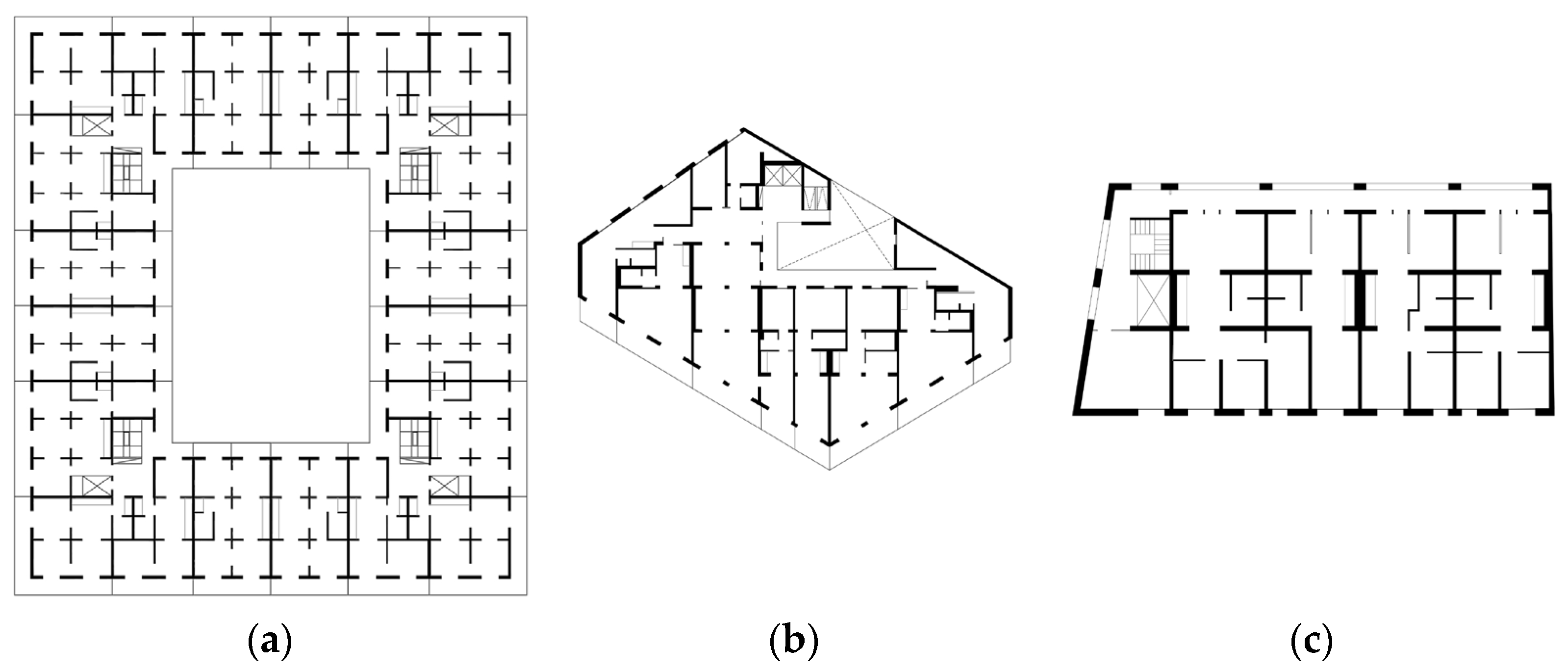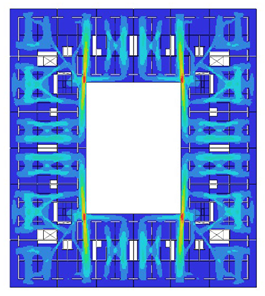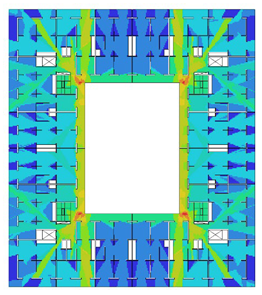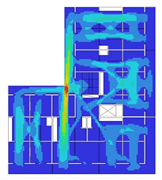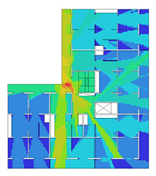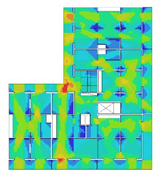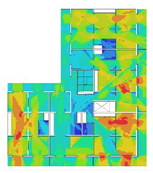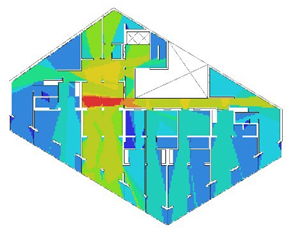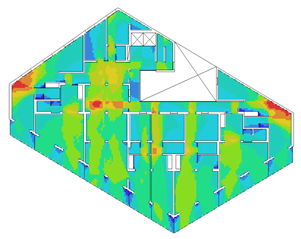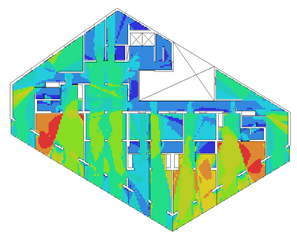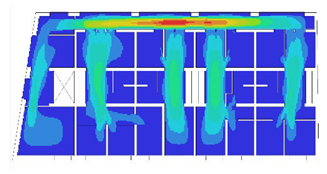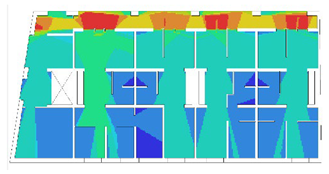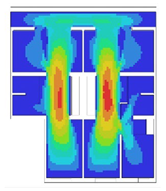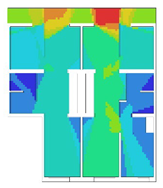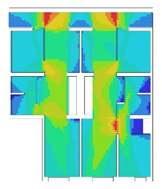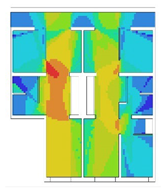1. Introduction
In recent years, shared housing models have emerged as alternatives to conventional housing, in response to rising urban housing costs and consequent housing affordability issues, changing household structures, increased mobility, and a growing desire for community-oriented lifestyles [
1,
2,
3]. These models are strongly linked to the conception of housing as a place and space for community interaction, hence proposing the existence of shared common spaces, which are being explored in both conventional housing and collaborative housing types (co-living and co-housing). And although collaborative housing presupposes shared social activities and greater communal life than conventional housing [
1], both arrangements challenge traditional spatial separations between the public and private realms within the home and its adjacent spaces. In this context, privacy becomes a relevant aspect, in all its dimensions: privacy expectations, privacy potential, privacy perception, and privacy effectiveness. Bearing this in mind, the paper proposes to uncover privacy patterns in shared housing environments, i.e., to understand how shared spaces’ characteristics (topology and spatial properties) may impact privacy, both within the dwelling and in its boundaries, using space syntax methods and measures, namely integration, through vision, control, and controllability. The main aim of this study is, therefore, to produce a critical analysis of recent housing developments that encompass shared spaces and promote communal living, through an assessment of privacy conditions. The paper thus contributes to a greater comprehension of the shared housing model and its liveability, identifying how spatial configuration in these housing types correlates with privacy gradients and examining how spatial arrangement enables or restricts autonomy and co-presence among residents. These insights contribute to a deeper understanding of how architecture can support privacy in shared living environments.
The findings reveal how spatial arrangements can either facilitate or constrain the negotiation of boundaries between private and shared life, also shedding light on the possibility of appropriation and territorialization (ownership) of some of the shared spaces. The research shows that higher segregation values tend to support more nuanced privacy practices. Conversely, highly integrated and visually exposed layouts may increase social encroachment into personal and private space and diminish opportunities for retreat. Ultimately, the study reframes privacy not as a fixed design feature or solely a matter of personal preference, but as a spatially embedded social practice. By offering empirical and analytical evidence, it seeks to inform the design of shared housing models that accommodate the diverse privacy requirements of contemporary urban dwellers, balancing the ideals of community with the need for individual autonomy.
1.1. Privacy: A Social Construct
Privacy–(noun) the state of being alone and not watched or interrupted by other people [
4].
The meaning of privacy as described above entails an important trifold condition: being alone, being ensconced, and being undisturbed. As Dienlin (2014) also establishes, its meaning also implies detachment (from others) and separation (through boundaries) [
5]. In domestic architecture, separation and detachment are achieved through functional differentiation and the introduction of spatial barriers. While the medieval home functioned as a public, multifunctional, and exposed environment, the spatial specialization of dwellings that emerged in the 17th century—marked by distinctions of function, gender, and hierarchy—gave rise to new socio-cultural constructs: domesticity and intimacy [
6,
7], both intrinsically linked to the evolving notion of privacy.
In the context of contemporary modes of living and dwelling practices, the notion of privacy emerges not merely as a matter of spatial separation but as a socially and culturally constructed phenomenon. Far from being a universal or static requirement, privacy is shaped by social norms, cultural expectations, architectural affordances, and interpersonal dynamics [
8,
9]. It involves both behavioural regulation and environmental negotiation [
8,
10], managing interaction, control, and the dichotomy between autonomy and collectivity [
11]. This dynamic quality is particularly salient in collaborative housing typologies, where shared spaces challenge conventional boundaries between private and communal life, requiring new forms of spatial and social negotiation.
Privacy in such settings is not the absence of others, but the ability to define and manage one’s social identity and relational boundaries. To this effect, control and choice become increasingly significant, namely the ability to control interactions with others and choose how and whether they take place [
8,
11,
12]. As Westin (1970) noted, physical settings thus play an important role in the perception and attainment of privacy [
13]. Spatial mechanisms that act as thresholds, such as doors, hedges, and transition spaces, are designed or added instinctively (and sometimes subconsciously) to protect one’s personal space [
8,
14], deeply linked to how people expect space to be used—expectations that vary from individual to individual or group to group, sometimes leading to territorial-behaviour-related conflicts [
8].
This paper draws on five interrelated concepts—personal space, control, barriers, territoriality, and sociability [
10]—to examine how privacy is experienced and negotiated within collaborative living environments. Together, these concepts provide a framework for analyzing how shared living environments balance the need for individual autonomy with collective life and how the three dimensions of privacy—being alone, being ensconced, and being undisturbed—are fulfilled.
1.2. Spatial Configurations and Privacy: An Overview of Recent Research
The relationship between privacy and housing has long been a subject of interdisciplinary inquiry, reflecting shifting cultural, social, and spatial understandings of domestic life. As housing models evolve to include more shared living arrangements, new challenges emerge in how privacy is negotiated, maintained, or redefined within communal contexts. This has given rise to a growing body of research that examines privacy not only as a psychological or social construct, but also as a condition shaped by architectural design and spatial organization. Within this field, this paper identifies three interrelated strands that bring relevant scholarship: (a) studies that explore privacy in the context of housing in general terms, (b) studies that propose an understanding of the practice of sharing and which focus specifically on privacy within shared housing environments, and (c) research that employs spatial analysis to assess how the built environment mediates privacy (
Table 1).
A fairly consensual approach to the subject highlights the importance of personal space and filter elements, comprehending the relevance of territorial behaviour in the relation one establishes with one’s home, both in terms of the development of a sense of ownership and the need (and possibility) for appropriation [
16,
17]. The expression of territoriality through appropriation of space is also perceived as a mechanism that supports community cohesion and engagement and fosters interaction between people [
15]. Additionally, also relevant is the management of the relation between public/social and private/intimate realms through spatial design and configuration, presented by Coelho (2011), as the balance between privacy and conviviality. To this end, two topics arise as significant: (i) the relevance of transition spaces, acting as boundaries and control devices that allow for privacy gradation and the regulation of interpersonal contact [
17,
18]; and (ii) the need to address noise and visual intrusion as aspects that hinder privacy [
16,
17,
18]. Both issues address the ability to control space and interpersonal relations through spatial properties and physical (and psychological) elements. And while some authors’ views consider this as a vital factor that determines the degree of privacy, others highlight the importance of balance between formal and informal use and interaction, as well as social/neighbouring commitment, collaboration, and cooperation, as key factors in shared spaces [
22,
24], the latter being contrary to the process of privatization. Nonetheless, several views agree that spatial properties (configuration, topology, area, and allocated uses) greatly impact interpersonal relations [
20,
22,
23,
24], sharing practices [
22,
24], wellbeing [
22], and, naturally, the perception of privacy [
16,
17,
18,
21,
22]. Aiming at a better understanding of how spatial configuration shapes privacy perception and effectiveness in housing environments (building and dwelling), some authors have proposed the examination of the object through space syntax theory, having also established a correlation between privacy perception and residential satisfaction (or adequacy) and a relation between spatial configuration and privacy levels [
25,
26,
27,
28].
While existing research, as this summarized overview attests to, provides valuable insights into the spatial, social, and psychological dimensions of privacy in housing, the relation between spatial configuration and spatial–functional definition of domestic settings (dwelling and communal spaces) and privacy (privacy perception and privacy potential) remains fairly unresearched, particularly regarding these emergent shared housing environments where the ‘binary codes’ [
26] overlap and boundaries become blurred. This study seeks to build on the foundations established by previous work and bridge this gap by addressing the intersection between spatial configuration and privacy patterns in shared environments, proposing an assessment of the spatial logic of privacy.
2. Materials and Methods
This research proposes a case-study analysis of shared housing developments, having selected case studies that promote shared spaces for shared activities with the intention of fostering social interaction. The case studies are located in Barcelona, where in recent years, innovative housing typologies have been being promoted and built, and housing models and functions discussed and questioned, following the municipal housing policy concerns expressed in the ‘Plan for the Right to Housing in Barcelona 2016–2025’, which incentivized and promoted the development of several housing developments (namely social housing and cooperative), some via design competitions [
2]. This wave elevated Barcelona to an intensive and profuse laboratory for new housing models and proposals, justifying the selection of this particular context for this research. Bearing in mind recent developments and proposals, two different types of housing models were selected for the analysis—social housing and cooperative housing—both with noticeable development in Barcelona.
The aim is to assess how privacy patterns are expressed in each housing model through spatial configuration specificities. The criteria for the case-study selection were based on diversity of design solutions: shared spaces typology and spatial configuration; dwelling layout; and the relation between dwelling and shared spaces (boundaries definition). From the pool of possible case studies, three were selected for examination:
Social Housing in Cornellá de Llobregat, Barcelona, Spain, 2020, Peris+Toral Arquitectes [
29];
Sotrac Cooperative, Barcelona, Spain, 2020, LaCol [
30];
La Balma Cooperative, Barcelona, Spain, 2021, LaCol + Laboqueria Taller d’Arquitectura [
31].
Acclaimed architects and buildings generally become paradigms and models. As such and apart from the criteria mentioned earlier, the case-study selection favoured award-nominated and award-winning developments and offices, to which architectural, social, or building quality was recognized: Cornellá de Llobregat Social Housing received the RIBA International Prize in 2024 and was a finalist in the Mies van der Rohe Awards in 2022; the Lacol office, responsible for both the Sotrac and La Balma Cooperative, have received important design awards, having been awarded the 2021 Moira Gemmill Prize for Emerging Architecture and having seen the La Balma cooperative recognized in the FAD Awards and Ibero-Architectural Biennial. The study thus proposes to assess privacy patterns and the privacy potential of housing developments whose quality has been recognized and highlighted. To assess privacy patterns in these built housing developments, the study proposes a methodology based on space syntax theory, which recognizes the correlation between spatial configuration and space use [
32] and offers methods that enable an effective representation and interpretation of spatial configuration [
33], examining how spatial design impacts core dimensions of privacy. Although a primarily objective tool, space syntax methods and results are able to convey occupants’ and users’ behaviour and subjective views (perceptions) [
28,
34], deeming it adequate for this study. Thus, through graphical representations—Visual Graph Analysis (VGA)—an immediate and visual comprehension of the relation between space and behaviour [
35] is attained, and the impact of spatial configuration on space use can be inferred.
To conduct the VGA and following a necessary initial stage of plans collection, for each case study, a floorplan was selected—either a typical floorplan (repeated throughout the building), or a floorplan where dwellings and shared spaces co-exist—and the plans were redrawn in CAD (
Figure 1 and
Figure 2).
The VGA was performed on Depthmap X (v 0.70) [
36] freeware and focused on the assessment of relevant measures that express spatial properties, allowing for an understanding of how spatial configuration mediates access, visibility, exposure, control, and proximity, via
through vision,
integration,
control, and
controllability, defined as follows:
To better understand the impact of shared spaces (existence and spatial configuration and topology) on privacy, the VGA was performed considering open doors—both dwelling access and interior doors. This specification is grounded in two aspects: (i) the intention behind the housing models conception of fostering greater communal living and provide shared spaces that can act as a physical extension of the dwelling space, allowing dwellers to appropriate these spaces; and (ii) the permeability of the dwelling access door, made of transparent materials (glass), also enabling greater connectivity and visibility between private and shared spaces. Similarly, the plans and VGA represent and take into consideration only fixed elements (walls, panels, and screens), which cannot be moved, opened, or simply removed, thus constituting effective barriers—for both visibility and circulation or flow.
The following section presents the results of the spatial analysis, with the representation of the VGA and its interpretation.
Generative intelligence (GenAI) has been used in this manuscript, providing support for the literature review section, namely supporting the tasks of scientific literature research and reference verification. All content was critically assessed and validated by the authors to ensure academic integrity and compliance with scholarly principles and ethical values.
3. Results
In this section, the VGA of each case study is presented. The results focus on the interpretation of privacy patterns both in the floorplan (as a system of spaces—shared and private) and in the dwellings (the non-collective unit of the system). The colour coding represents the range from high to low values of the presented measures, with the following scale (high to low): red, orange, yellow, green, teal, blue, and dark blue. The section is divided into sub-sections, each corresponding to a case study.
3.1. Social Housing in Cornella de Llobregat
The Peris+Toral Social Housing at Cornella de Llobregat, in Barcelona, is an 85-dwelling building, with flexible room plans for diverse living arrangements, structured in an O-shaped building, around a square inner courtyard. Facing this courtyard, on the residential floors, the architects designed a gallery-like space, composed of outdoor private spaces that allow access to the dwellings.
The examination of the typical floorplan VGA (
Table 2) reveals the important role of the distribution space, surrounding the inner courtyard, despite it not being continuous. This transition space is highly integrated (central and visible) and shows high potential as a preferential pathway. The integration values show that the communal space that is adjacent to the vertical accesses (lift and staircase) is the most central space in the floor plan, consisting of a key node (visual convergence) and demonstrating potential for resident interaction.
For the dwelling examination, a section of the plan was chosen, representing one of the access nuclei and five dwellings (
Table 3). The through vision analysis shows lower visibility values inside the dwellings, suggesting adequate separation between private and communal spaces and some protection from visual intrusion. The exception to this examination is a large part of the dwelling located in close vicinity to the access nucleus and whose compartments are in a straight line of sight with the ‘gallery’, showing higher levels of visual permeability and greater likelihood of being encroached upon. The integration analysis is consistent with this reading and demonstrates, additionally, the more private nature of the dwellings that are located the furthest from the access nucleus and the ‘gallery’ corner, which is reiterated as a key control space (more integrated and with higher control value). The control and controllability measures also show us the areas of the ‘gallery’ which have greater potential for appropriation and territorialization—the spaces that are in direct connection with the dwelling doors.
Within the dwelling, the spaces that show greater potential for privacy are those with (darker) blue hues. The fact that the dwellings allow for greater choice (space configuration and movement) can hinder privacy in some configurations, namely when all compartments are connected and opened to one another. In this case, as depicted, almost all dwellings present high levels of controllability, which is indicative of highly exposed spaces, with little capability for offering privacy.
3.2. Sotrac Cooperative
The Sotrac Cooperative is a seven-floor residential building, featuring 38 dwellings and shared spaces—communal kitchen and multipurpose/communal rooms—whose distribution system is based on a gallery circulation through which access to dwellings is made. For the VGA, the floor with the highest surface of communal areas was chosen (
Table 4). Both the through vision and the integration measures demonstrate the significance of these areas in the plan, highlighting their central character. The distribution gallery and atria also show high levels of integration, which is indicative of their role in the distributive system. The spaces with high values of integration and through vision—communal areas and distribution spaces—represent spaces where social interaction has a higher potential of occurring. These are also spaces and areas where privacy is lowest because visual exposure is greater.
Analyzing the privacy potential of the dwellings, the VGA reveals that some areas in the dwelling units are prone to visual encroachment (areas in light blue hue in the through vision image), potentially hindering privacy needs and expectations. Nonetheless and interestingly, in the gallery-adjacent dwellings and, albeit this proximity, the spaces where privacy is likely to be more effective are the first-tier compartments, which have lower levels of visual exposure and controllability, indicating the potential for individual/household seclusion if desired. A comparison of the privacy patterns of the different dwellings in this typical floorplan shows that the units whose access is made by the gallery have similar average integration values and that the unit with the lowest average integration values is the smaller dwelling, whose entrance is via the shared space. This dwelling also shows lower levels of controllability, indicating higher potential for privacy.
3.3. La Balma Cooperative
La Balma Cooperative features 20 dwellings across six floors, and several communal areas—the dining room, multipurpose room, library, workspace, laundry, among others. On each floor, in addition to the dwellings, one shared space is offered. The distribution system to the dwellings is a shared gallery, which the typical floorplan VGA demonstrates has an extremely central role, with high levels of integration and through vision. The latter is consistent with high traffic and exposed spaces, revealing the distribution character of this space and its potential for social interaction (
Table 5). The VGA also shows that, unlike the gallery, the shared space is somewhat segregated and secluded, which is conducive to a more privatized use, albeit a communal area.
The highly integrated and visible character of the gallery impacts the privacy levels inside the dwellings. The analysis (
Table 6) shows that the set of compartments in direct perpendicularity to the gallery has high values of exposure (through vision and controllability) and, consequently, less privacy. In accordance, the areas in the gallery with higher potential for appropriation and to become extensions of the dwellings are those near the units’ entrances (high levels of integration and control). Within the dwelling system, the central tier (kitchen infrastructure) is the hub of the unit, with high control, controllability, and exposure levels. In opposition, the satellite compartments (those not in the gallery–kitchen axis) show greater potential for privacy.
4. Discussion
Following the space syntax analysis, through VGA, the study unveils privacy patterns in shared housing environments, proposing an interpretation of how spatial configurations in shared housing models impact privacy dynamics and how personal space, control, barriers, territoriality, and sociability unfold. In light of the VGA results and drawing from relevant privacy facets and dimensions brought forth by the literature review, three relevant aspects of privacy are discussed—Barriers and Privacy Control, Personal Space and Territoriality, and lastly, Sociability—and a discussion of how design solutions can mediate the shared and private domains is proposed.
4.1. Barriers and Privacy Control
The existing literature considers barriers as important and effective means of managing and acquiring privacy, either through transition spaces or construction elements (walls and screens), which act as boundaries and thresholds between communal and private realms. The VGA analysis of the selected case studies demonstrates that the lack of transition spaces and space dividers (uncompartmentalized interiors) inside the dwellings results in more exposed, visually encroached, and less private or ‘privatizable’ domestic spaces, shifting the balance between privacy and conviviality. In the three case studies, a direct line of sight is traced from the shared space and across the (private) dwelling (especially noticeable in the Through Vision images), hindering or restricting the possibility of privacy.
The analysis also shows that the boundaries between communal (atria and galleries) and private areas (dwellings) have high integration values; in fact, the highest value of the dwelling spaces demonstrates once more the importance of these thresholds and their potential in managing privacy. This management is also very dependent on visibility relations, from exposure to concealment. To this effect, the VGA shows that thresholds and boundaries (either communal–private or within the dwelling) display medium to high levels of control, indicating that social interaction and encounter are favoured in these spaces because visibility onto others and other spaces is high. Privacy control or effectiveness is, however, hindered in spaces where controllability is higher, as the VGA demonstrates, as is the case with most of the dwellings in the Cornellá de Llobregat example (considering the more flexible spatial arrangement, where all compartments are physically linked), the La Balma dwellings, and a few of the Sotrac dwellings. In these, the dwelling spaces are highly exposed and visible, and privacy regulation is made difficult. In some of the analyzed dwellings, the visual exposure spans across the dwelling and prolongs onto the shared space (most apparent in the through vision and controllability measures), which reflects the low range of privacy potential of those dwelling spaces.
4.2. Personal Space and Territoriality
An important facet of privacy and privacy expectations is the search and creation of personal space (safe space), also associated with a sense of belonging and ownership, a manifestation of territorial behaviour. In shared housing environments, the communal aspect of living takes precedence over the individual/household. Nonetheless, in most models, residents are encouraged to extend their private living space and dwelling activities onto the shared spaces, appropriating and occupying common areas, such as the gallery space adjacent to the dwelling (as is the case of La Balma and Sotrac). The VGA demonstrates that these spaces are highly exposed, central and play a vital role in the distribution system of the floorplan, meaning they represent spaces most likely to be traversed (high integration and through vision values), which can lead to conflicts arisen from the incompatibility between the distribution function of the space and residents’ appropriation (furniture or plant placement, and activities). Spatial configuration is paramount in managing this clash: wider galleries or galleries with alcoves can offer a better fit between personal space/personal expectations and shared space/communal living.
Another relevant component of personal space and territoriality relates to privacy within the dwelling and the household. The space syntax analysis reveals that uncompartmentalized layouts or arrangements (present in all the case studies) are not conducive to the definition and management of degrees of privacy, showing high levels of control and controllability, indicating high exposure and visibility, and, consequently, little privacy. In these highly exposed interiors, the possibility of being alone and secluded is diminished, and privacy regulation becomes impaired. The VGA of the three case studies demonstrated that in the majority of the dwellings, only one space shows potential for seclusion, i.e., privacy, namely the room furthest away from the shared area and not on the direct axis to this common space.
4.3. Sociability
As already mentioned, shared housing environments emphasize the importance of communal living and offer communal amenities and spaces for social interactions and encounters. These spaces are meant to foster sociability and create a sense of community amongst the residents. As such, the spatial configuration and topology of these areas are of great importance: well-placed shared areas can foster interaction, whereas segregated spaces may not engage residents, hampering communal living. The case studies’ VGA demonstrated that in two case studies—Cornellá de Llobregat and Sotrac—the communal areas are the most central in the floorplan organization (high integration) and show high levels of control over other spaces, with both measures indicating that the communal areas are indeed a place for encounters and interactions and that their location fosters these activities. The through vision analysis is also consistent with these findings. In the La Balma cooperative, however, the shared space is marginal to the floorplan structure and shows low levels of integration and through vision, which indicates that this space may function as an extension of private dwellings and hold private activities rather than communal ones, which will likely occur in the gallery.
In these shared spaces, visual exposure is beneficial, and privacy is not a requirement.
4.4. Design as Mediator
The previous segments seek a contribution towards a greater understanding of the spatial logic of privacy in shared housing environments and the impact of spatial configuration in managing privacy. The results demonstrate that design solutions and conceptualizations can favour or hinder privacy potential by impacting the materialization of relational boundaries and providing settings for interaction control. Recognizing, then, the importance and influence of spatial configuration and architectural features, some directions and principles can be adopted to better mediate the relation between shared and private spheres, lessening the possibility for conflicts and facilitating the negotiation of space. To this effect, both effective (physical) and perceptible/sensible solutions could be explored:
The introduction of transition spaces to foster the mediation between collective and individual settings. Transition spaces operatively define boundaries and manage encroachment issues by providing neutral settings where shared and private become blurred and where overlapping is tolerated.
Creating depth in dwellings. Compartmentalized dwellings provide greater privacy potential as they offer the possibility of rooms further away from the collective spaces.
Managing the dimensions of hybrid spaces, such as access galleries that double as an extension of indoor private spaces. Narrow spaces heighten the likelihood of conflicts and encroachment, while wider spaces will enable the creation of different zones, such as pockets for indoor extension and pathways for circulation. Both the La Balma and Sotrac cooperatives display narrow galleries, which the VGA identifies as highly exposed spaces, confirming this reasoning.
These solutions and strategies allow for the definition of barriers, either physical or sensory, and manage the relation between sociability and personal space.
By using space syntax, spatial properties have become noticeable, and privacy patterns and potential have become inferable. As a result, this method can be applied to study other dwelling typologies, such as student housing and senior housing, whose relationship between shared and private is somewhat different. Although in the present study the VGA has provided significant and meaningful findings, further research is proposed and planned to provide a more complete assessment of contemporary shared housing dwellings’ privacy potential and privacy dynamics. To this effect, two research foci are defined:
An in-depth assessment of the privacy potential of a single case study whose layout allows for variations and different privacy gradients and privacy management devices, recognizing the importance of moveable elements (doors, panels) and permeable elements (which enable visibility–windows, openings), using the space syntax VGA method;
A post-occupancy evaluation and the assessment of residential satisfaction of these shared environments, to provide a more holistic view of the issue and allow for confirmation of the presented results and a comprehension of privacy expectations in shared housing environments. In these settings, community and communal living may be prioritized over individual privacy and the ability to be secluded, leading to a shift in privacy expectations and the perception of encroachment.
Even though the latter is considered a pertinent research course, as previous research has demonstrated [
28,
34], space syntax findings have been consistent with POE results, validating and substantiating the proposed methodology and the obtained results. In addition, the study highlights the relevance of space syntax methods for the design stage, when different layouts are experimented with and design choices are set, as it allows for an immediate examination of how different spatial configurations may influence behaviour, use, and social interactions, strengthening the rationale behind design decisions.
5. Conclusions
This study proposed to understand how shared spaces (topology and spatial properties) could impact individual or household privacy, both within the dwelling and in its boundaries, taking into consideration the meaning of privacy that refers to the possibility to control interaction with others, to be alone and unwatched. The case-study analysis through space syntax Visual Graph Analysis (VGA) confirmed that spatial configuration in shared housing arrangements has a direct and noticeable impact in privacy potential and privacy patterns, revealing that (i) highly exposed and controlled spaces are less prone to be privatized and provide less opportunities for seclusion and retreat; (ii) boundaries and transition spaces are elements that potentiate and manage privacy degrees; (iii) sociability is favoured in highly integrated and exposed spaces; (iv) shared space appropriation may lead to conflicts depending on spatial configuration of these areas and their topology. The examination of the case studies uncovered the impact of design solutions and design choices on privacy potential, through the assessment of exposure, visibility, seclusion, and control levels, identifying design traits that are not conducive to privacy or private behaviours and activities. As a result, the paper highlights a few design strategies that could mediate the relation between shared and private domains and foster the gradation of intimacy, namely via the creation of space (distance) or thresholds, which act as screens between the two spheres.
Notwithstanding, as Altman [
8] suggests, privacy is not constant or universal; it varies from person to person and throughout one’s life. Recognizing this inconstant nature, this paper affirms the need to comprehend the contemporary meaning of privacy, especially within shared housing environments, where the expectations of privacy may be distinct. In these settings, community living is paramount, and conviviality is fostered and prioritized. Boundaries (collective vs. individual) may thus become blurred, and privacy, as the ability to be secluded, yields to communal gathering. Bearing this in mind, it is important to allow spaces to adapt and be adapted to changing privacy needs and expectations, and as such, consider how spatial configuration and organization can be conceived to enable residents to successfully manage and regulate privacy and social interaction.
Ultimately, this study highlights the critical role of spatial configuration and architectural design of shared housing environments in shaping behaviour, managing and negotiating privacy, while balancing communal life and sociability with the need to be secluded and to retreat. The research thus contributes to the scholarly discussion and reflection of privacy in shared housing while also providing valuable insights for architects and promoters regarding the balance between autonomy and collectivity through design solutions. Lastly, the study also highlights the relevance of space syntax as both an analytical and predictive tool, cementing its importance to the comprehension of how spatial configuration can impact use, hence demonstrating its validity as a research methodology in architecture.
Author Contributions
Both authors have been equally engaged in the development of the present research and the preparation and conclusion of this article, collaborating in all stages and sections of this document. Conceptualization, A.M. and F.S.; methodology, A.M. and F.S.; formal analysis, A.M. and F.S.; investigation, A.M. and F.S.; writing—original draft preparation, A.M. and F.S.; writing—review and editing, A.M. and F.S. All authors have read and agreed to the published version of the manuscript.
Funding
This research was funded by the Foundation for Science and Technology’s support through funding UIDB/05703 from the research unit CiTUA.
Data Availability Statement
The original contributions presented in this study are included in the article material. Further inquiries can be directed to the corresponding author.
Acknowledgments
During the preparation of this manuscript, the authors used ChatGPT for the purposes of scientific literature research and reference verification. The authors have critically assessed the output and take full responsibility for the content of this publication.
Conflicts of Interest
The authors declare no conflicts of interest. The funders had no role in the design of the study; in the collection, analyses, or interpretation of data; in the writing of the manuscript; or in the decision to publish the results.
Abbreviations
The following abbreviations are used in this manuscript:
References
- Czischke, D.; Peute, M.; Brysch, S. Together: Towards Collaborative Living; Nai010 Publishers: Rotterdam, The Netherlands, 2023. [Google Scholar]
- Avilla-Royo, R.; Jacoby, S.; Bilbao, I. The Building as a Home: Housing Cooperatives in Barcelona. Buildings 2021, 11, 137. [Google Scholar] [CrossRef]
- Tummers, L. The re-emergence of self-managed co-housing in Europe: A critical review of co-housing research. Urban Stud. 2016, 53, 2023–2040. [Google Scholar] [CrossRef]
- Oxford Dictionary. Available online: https://www.oxfordlearnersdictionaries.com/definition/english/privacy (accessed on 21 July 2025).
- Dienlin, T. The Privacy Process Model. In Medien und Privatheit; Garnett, S., Halft, S., Herz, M., Mönig, J.-M., Eds.; Stutz: Passau, Germany, 2014. [Google Scholar]
- Moreira, A.; Farias, F. Gendered Spaces at Home. Feminine and Masculine Traits in Domestic Interiors. Int. J. Soc. Sci. Stud. 2022, 10, 91–104. [Google Scholar] [CrossRef]
- Rybczynski, W. Home: The History of an Idea; Pocket Books: London, UK, 2001. [Google Scholar]
- Altman, I. The Environment and Social Behaviour: Privacy, Personal Space, Territory, Crowding; Brooks/Cole Pub. Co.: Monterey, CA, USA, 1975. [Google Scholar]
- Rapoport, A. House Form and Culture; Prentice-Hall, Inc.: Englewood Cliffs, NJ, USA, 1969. [Google Scholar]
- Macedo, P.; Ornstein, S.; Elali, G. Privacy and Housing: Research perspectives based on a systematic literature review. J. Hous. Built Environ. 2022, 37, 653–683. [Google Scholar] [CrossRef] [PubMed]
- Chermayeff, S.; Alexander, C. Community and Privacy: Toward a New Architecture of Humanism; Doubleday & Company, Inc.: New York, NY, USA, 1963. [Google Scholar]
- Wolfe, M. Childhood and Privacy. In Children and the Environment Human Behavior and Environment (Advances in Theory and Research); Altman, I., Wohlwill, J.F., Eds.; Springer: New York, NY, USA, 1978; Volume 3, pp. 175–222. [Google Scholar] [CrossRef][Green Version]
- Westin, A. Privacy and Freedom; Atheneum: New York, NY, USA, 1970. [Google Scholar][Green Version]
- Hall, E. The Hidden Dimension; Anchor Books: New York, NY, USA, 1990. [Google Scholar][Green Version]
- Brunson, L.; Kuo, F.; Sullivan, W. Resident Appropriation of Defensible Space in Public Housing. Implications for safety and community. Environ. Behav. 2001, 33, 626–652. [Google Scholar] [CrossRef]
- Ozaki, R. Housing as a Reflexion of Culture: Privatised Living and Privacy in England and Japan. Hous. Stud. 2001, 17, 209–227. [Google Scholar] [CrossRef]
- Lindsay, M.; Williams, K.; Dair, C. Is there room for privacy in the compact city? Built Environ. 2010, 36, 28–46. [Google Scholar] [CrossRef]
- Coelho, A. A Privacidade Arquitectónica No Habitar. Infohabitar 2011, VII, 342. Available online: https://infohabitar.blogspot.com/2011/04/privacidade-arquitectonica-no-habitar.html (accessed on 21 July 2025).
- Lawrence, R. Community and Privacy in a Hyper-Connected World. Urban Plan. 2023, 8, 169–171. [Google Scholar] [CrossRef]
- Williams, J. Designing Neighbourhoods for Social Interaction: The Case of Cohousing. J. Urban Des. 2005, 10, 195–227. [Google Scholar] [CrossRef]
- Lee, S. A Study on the Changes in Sharehouse Design in Korea. Buildings 2021, 11, 307. [Google Scholar] [CrossRef]
- Kleeman, A.; Giles-Corti, B.; Gunn, L.; Hooper, P.; Foster, S. The Impact of the Design and Quality of Communal Areas in Apartment Buildings on Resident’s Neighbouring and Loneliness. Cities 2022, 133, 104126. [Google Scholar] [CrossRef]
- Chang, J.; Zhang, Y. Sharing space: Urban sharing, sharing a living space, and shared social spaces. Space Cult. 2021, 24, 157–169. [Google Scholar] [CrossRef]
- Heath, S. Balancing the formal and the informal: The relational challenges of everyday practices of cooperation in shared housing co-operatives in the UK. Soc. Cult. Geogr. 2020, 22, 1256–1273. [Google Scholar] [CrossRef]
- Reis, A.T.; Lay, M.C. Privacidade na Habitação: Atitudes conexões visuais e funcionais. Ambiente Construído 2003, 3, 21–33. [Google Scholar]
- Mustafa, F.A.; Hassan, A.S.; Baper, S.Y. Using Space Syntax Analysis in Detecting Privacy: A comparative study of traditional and modern house layouts in Erbil city, Iraq. Asian Soc. Sci. 2010, 6, 157–166. [Google Scholar] [CrossRef]
- Alitajer, S.; Nojoumi, G. Privacy at Home: Analysis of behavioural patterns in the spatial configuration of traditional and modern houses in the city of Hamedan based on the notion of space syntax. Front. Archit. Res. 2016, 5, 341–352. [Google Scholar] [CrossRef]
- Moreira, A.; Serdoura, F. Evaluating User Satisfaction and Dwelling Program Performance and Adequacy in Studio Apartments, in Lisbon. In Proceedings of the 14th Space Syntax Symposium, Nicosia, Cyprus, 24–28 June 2024. [Google Scholar]
- Peris+Toral Arquitectes. Available online: https://peristoral.com/proyectos/modulus-matrix-85-social-housing-cornella (accessed on 15 September 2025).
- LaCol. Available online: https://lacol.coop/projectes/sotraca/ (accessed on 15 September 2025).
- LaCol. Available online: https://lacol.coop/projectes/la-balma/ (accessed on 15 September 2025).
- Hanson, J. Decoding Homes and Houses; Cambrigde University Press: Cambridge, UK, 1998. [Google Scholar]
- Hillier, B.; Hanson, J.; Graham, H. Ideas are in things: An application of the space syntax method to discovering house genotypes. Environ. Plan. B Plan. Des. 1987, 14, 363–385. [Google Scholar] [CrossRef]
- Moreira, A.; Serdoura, F. Modernist Dwellings in Lisbon, Portugal. Reading home use and transformation through syntactic analysis. In Digital Techniques Applied to Design Process; Lima, F., Borges, M., Ribeiro Costa, F., Eds.; UFJF Press: Juíz de Fora, Brazil, 2019. [Google Scholar]
- Koutsolampros, P.; Sailer, K.; Varoudis, T.; Haslem, R. Dissecting Visibility Graph Analysis: The Metrics and their Role in understanding Workplace Human Behaviour. In Proceedings of the 12th Space Syntax Symposium, Beijing, China, 8–13 July 2019. [Google Scholar]
- depthMapX. Available online: https://www.spacesyntax.online/software-and-manuals/depthmap/ (accessed on 15 July 2025).
- Hillier, B.; Hanson, J. The Social Logic of Space; Cambridge University Press: Cambridge, UK, 1984. [Google Scholar]
- Turner, A. Depthmap: A Program to Perform Visibility Graph Analysis. In Proceedings of the 3rd International Symposium on Space Syntax, Atlanta, GA, USA, 7–11 March 2001. [Google Scholar]
| Disclaimer/Publisher’s Note: The statements, opinions and data contained in all publications are solely those of the individual author(s) and contributor(s) and not of MDPI and/or the editor(s). MDPI and/or the editor(s) disclaim responsibility for any injury to people or property resulting from any ideas, methods, instructions or products referred to in the content. |
© 2025 by the authors. Licensee MDPI, Basel, Switzerland. This article is an open access article distributed under the terms and conditions of the Creative Commons Attribution (CC BY) license (https://creativecommons.org/licenses/by/4.0/).
